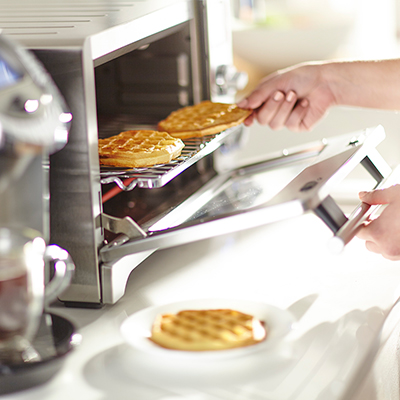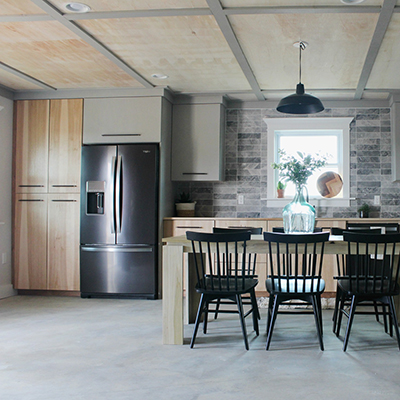How to Measure Microwaves: Sizes & Tips

Published July 14, 2024
Whether you're upgrading your kitchen appliances or replacing an old microwave, getting accurate measurements for microwave sizes is key to ensuring a perfect fit. This guide will give you a step-by-step process of how to measure a microwave like a pro.
Difficulty:
Beginner
Duration:
Under 2 hours
Table of Contents
Microwave Size Chart
Standard Microwave Sizes
Specialty Microwave Sizes
Tips for Choosing the Right Microwave Size
How to Measure a Microwave: Step-by-Step
Microwave Size Chart

Microwave dimensions vary depending on the type and purpose. This microwave size chart is a useful reference. It can help you get the details of different aspects of sizing as you prepare to purchase a new appliance.
Standard Microwave Sizes

Standard microwaves come in a variety of sizes that are designed to fit almost any home’s kitchen. Each type has a typical range, as the microwave size chart indicates. This will help you know what to expect when you buy one. But keep in mind that these are estimates for standard microwave size ranges. You may find different measurements when you’re shopping.
Countertop microwaves are made to fit average-sized kitchen counters with a decent amount of available space. They can be placed on any surface, including tables, counters and microwave stands, as long as it’s level and stable. Some models can be integrated into cabinets using a specialized kit.
- Height: Most are around 13 inches, but can range from 12 to 15 inches
- Width: 21 to 25 inches
- Depth: 16 to 20 inches, 34 to 39 inches with the door open
- Capacity: 1.0 to 2.2 cubic feet
Compact/small microwaves are small versions of countertop ones. They work well in small apartment kitchens, rooms or RVs.
- Height: 10 to 12 inches
- Width: 15 to 19 inches
- Depth: 12 to 16 inches, 23 to 30 inches with the door open
- Capacity: 0.5 to 0.9 cubic feet
Built-in microwaves are designed to only be installed into cabinets or under counters. No surfaces are needed. Some have doors that open on the side, like countertop models, while others have doors that open downward like an oven. Most need to be professionally installed.
- Height: 17 to 22 inches
- Width: 24, 27 or 30 inches, matching most cabinet widths
- Depth: 20 to 25 inches, 30 to 35 inches open
- Capacity: Most are 1.2 to 1.6 cubic feet, though the range can be 1.0 to 2.2 cubic feet
Over-the-range microwaves, just like built-in models, don’t need countertop space. They are installed above stoves, and they function as a vent or hood for cooking smoke, smells and grease. Some will hang below the cabinet, but that’s fine as long as there is 30 inches between the microwave and the range.
- Height: 17 inches
- Width: 30 inches for standard ranges, 24 inches for compact models
- Depth: 15 to 18 inches, 42 to 45 inches with the door open
- Capacity: Usually 1.7 to 2.0 cubic feet, but can range from 0.8 to 2.1 cubic feet
Specialty Microwave Sizes

Commercial microwaves, as the name suggests, are intended for commercial food service operations, including restaurants and cafeterias. They have higher wattages and are more powerful than most home microwaves, shortening cook times for food.
- Designed to be used frequently.
- More durable than their non-commercial counterparts.
- Light, medium or heavy-duty based on daily usage.
- Power ranges from 1000 watts up to more than 3000 watts.
- Capacities range from as small as 0.3 to 0.8 cubic feet all the way up to 1.2 to 1.6 cubic feet.
- Range of sizes from 13 inches wide to more than 2 feet wide and deep.
- Some models have internal venting and other special features.
Convection microwaves are small appliances that have two modes for cooking food: microwave or convection modes. Microwaves cook using electromagnetic waves, while convection cooks by having a fan circulate heat from a heating element. Traditional convection ovens are usually large appliances, but when combined with a microwave, they can be used on a smaller scale.
- Convection microwaves can be standard compact, countertop, over-the-range or built-in, and they have the same footprint ranges as the non-convection models.
Tips for Choosing the Right Microwave Size

Selecting the right microwave size is essential for ensuring it fits your needs, kitchen space and budget. Here are some helpful tips to guide you through the decision-making process:
Needs: Consider how you plan to use your microwave. Do you primarily use it for reheating leftovers, cooking meals or defrosting frozen food? If you have a large family or frequently cook larger dishes, you may need a larger microwave with higher capacity. If you have limited counter space or live alone, a smaller microwave may suffice.
Microwave dimensions: Look at the available space in your kitchen to determine the appropriate size for your microwave. You may have a standard microwave size or a varying size. Measure the area where you plan to place the microwave, including both countertop and overhead space if considering an over-the-range model. Ensure there is enough clearance for ventilation and proper functionality, especially if opting for a built-in or under-counter microwave.
Placement: Think about where you want to place your microwave within your kitchen layout. If you have limited counter space, a compact countertop microwave or an over-the-range model may be the best options to maximize space efficiency. If you prefer a seamless look, built-in or drawer-style microwaves offer a sleek and integrated appearance but may require professional installation.
Budget: Larger microwaves with higher capacities and advanced features typically come with a higher price tag. Evaluate your budget and prioritize features that are most important to you, whether it's size, power or additional settings like convection cooking or sensor technology.
How to Measure a Microwave: Step-by-Step

Here's a detailed, step-by-step guide on how to measure a microwave:
Step 1. Gather your tools:
- Tape measure or ruler
- Laser level
- Pencil/pen and paper or app to record your measurements
Step 2. Prepare the area:
- Remove any items or clutter from the countertop or shelf for easy access for measuring.
- If you’re measuring your current microwave, unplug it and remove anything inside of it.
- For built-in and over-the-range microwaves, you’ll be measuring the cutout where the current microwave is installed or the empty space for a new one. You may want to remove the microwave first.
Step 3. Measure the width:
- Using the tape measure or laser level, measure horizontally across the widest exterior sides of the microwave.
- For over-the-range and built-in units, be sure to measure the width of the cutout — the area where you’ll be doing the new installation. If you’re installing it between a cabinet and a wall, and the microwave door will swing open toward the wall, there must be a 6-inch clearance between the unit and the wall.
Step 4. Measure the height:
- Next, measure vertically along one exterior side of the microwave, making sure it is straight and flush against the surface.
- For built-in and over-the-range microwaves, measure the height of the cutout.
Step 5. Measure the depth:
- Measure the depth of the microwave from the front to the back with the door closed.
- For built-in and over-the-range microwaves, measure the depth of the cutout.
Step 6. Record additional measurements (if applicable):
- If your microwave has any protruding features such as handles, knobs or vents, measure their width, height and depth separately. These measurements will help you determine the total clearance needed for proper placement and ventilation.
Step 7. Consider clearance requirements:
- Keep in mind any clearance requirements specified by the manufacturer for proper ventilation and functionality.
- Measure the space around the microwave to ensure adequate clearance from walls, cabinets, and other obstacles.
- Most microwaves require at least 1 inch between the wall and the appliance for ventilation, but you should follow the manufacturer’s instructions.
- For standard or compact countertop microwaves, allow at least 3 inches in front to reduce tipping when opening the door.
- Countertop microwaves need to be at least 2 feet away from the stove/range.
- For over-the-range units, even if it drops below the height of the cutout, make sure the space between the microwave and the range below is at least 30 inches.
Step 8. Double-check your measurements:
- Before making any purchasing decisions, double-check your measurements to ensure accuracy.
- Compare your recorded measurements to the specifications provided by the manufacturer to confirm compatibility with your space and intended placement.
Now that you know how to measure a microwave, it's time to take the next step. Visit The Home Depot in person or use The Home Depot Mobile App for all your microwave and kitchen needs.



























